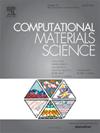A universal ML model for segregation in W
IF 3.1
3区 材料科学
Q2 MATERIALS SCIENCE, MULTIDISCIPLINARY
引用次数: 0
Abstract
Segregation of solute elements to grain-boundaries (GB) in alloys is a key process controlling material properties. Examples are phase transformations, strength, or nanocrystalline stability. The central quantities to predict GB segregation are the site-specific segregation energies which can be accurately calculated using density functional theory (DFT). To reduce the computational cost, machine learning (ML) models are trained on DFT segregation data to predict the segregation energies. Here, we combine descriptors for the local structure of the segregation site with element-specific parameters for the solute element to train ML models that can predict the site-specific segregation energies for a wide range of elements. We use cross-validation and extrapolation scores to find the optimal set of descriptors for the model. The thus obtained model is then used to predict the segregation energies of solutes that are not in the data set. We apply our approach to segregation of transition metals in W. Both, cross-validation scores and comparison to literature data highlight excellent results of the ML approach. We make the model available by publishing the relevant codes and data.

一个通用的ML分离模型
合金中溶质元素向晶界偏析是控制材料性能的关键过程。例如相变、强度或纳米晶体稳定性。利用密度泛函理论(DFT)可以精确地计算出特定位置的偏析能,是预测GB偏析的中心量。为了降低计算成本,利用DFT偏析数据训练机器学习模型来预测偏析能。在这里,我们将偏析位点的局部结构描述符与溶质元素的特定元素参数结合起来,训练ML模型,该模型可以预测大范围元素的特定位置偏析能。我们使用交叉验证和外推得分来找到模型的最佳描述符集。这样得到的模型然后被用来预测数据集中没有的溶质的偏析能。我们将我们的方法应用于w中过渡金属的分离,交叉验证分数和与文献数据的比较都突出了ML方法的出色结果。我们通过发布相关代码和数据使模型可用。
本文章由计算机程序翻译,如有差异,请以英文原文为准。
求助全文
约1分钟内获得全文
求助全文
来源期刊

Computational Materials Science
工程技术-材料科学:综合
CiteScore
6.50
自引率
6.10%
发文量
665
审稿时长
26 days
期刊介绍:
The goal of Computational Materials Science is to report on results that provide new or unique insights into, or significantly expand our understanding of, the properties of materials or phenomena associated with their design, synthesis, processing, characterization, and utilization. To be relevant to the journal, the results should be applied or applicable to specific material systems that are discussed within the submission.
 求助内容:
求助内容: 应助结果提醒方式:
应助结果提醒方式:


